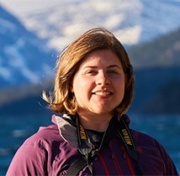Maya Soukup

BSc Honours
B.Sc. (Honours) Thesis
(PDF - 3.6 Mb)
Terrestrial Cosmogenic Nuclide (TCN) methods have been traditionally focused on the measurement of radionuclides in the top 4 m of the lithosphere down to where calibrated data exists at depths of <30 m. Improvements in TCN target chemistry and Accelerator Mass Spectrometry have provided an opportunity to expand this depth in an effort to address previously intractable questions regarding topographic evolution. The primary objective of this thesis is to test the validity and reproducibility of measuring a long-lived TCN (10Be, t陆= 1.39 Ma) using muon-produced nuclides at great depths. The secondary objective of this thesisinvolves applying this method to study the history of incision and large scale relief generation.
The test site for the application is a small valley near the Book Cliffs, Utah. The results of AMS聽 measurements on 6 BeO targets prepared from deeply shielded quartzite suggest that muogenic 10Be can be measured with sufficient precision at depths exceeding 100 m to establish when a valley may have evolved over million-year timescales.
Keywords: Muon, TCN, 10Be, topography, incision
Pages: 60
Supervisor: John Gosse



